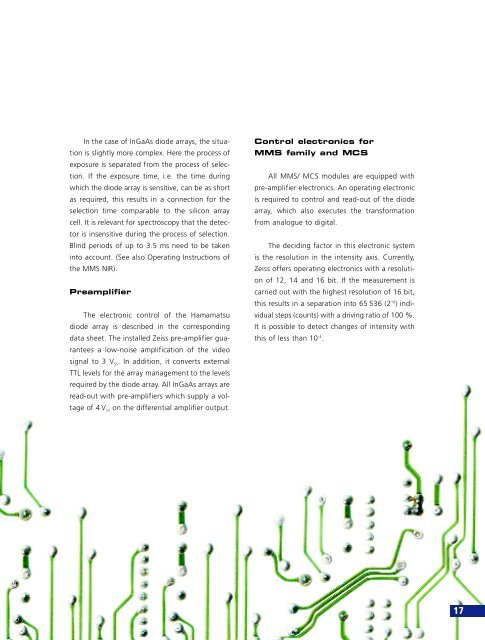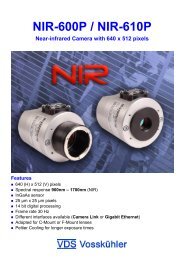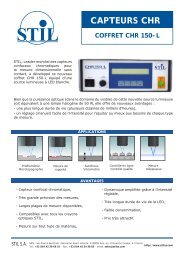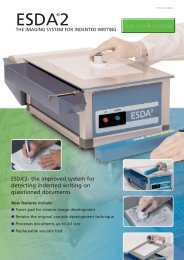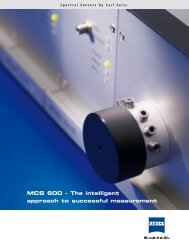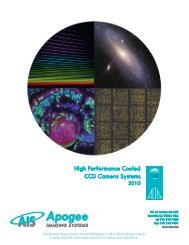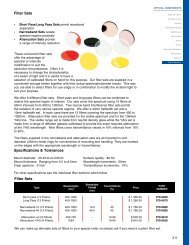MMS â Monolithic M i n i a t u re - S p e c t ro m e t e r - Photon Lines
MMS â Monolithic M i n i a t u re - S p e c t ro m e t e r - Photon Lines
MMS â Monolithic M i n i a t u re - S p e c t ro m e t e r - Photon Lines
You also want an ePaper? Increase the reach of your titles
YUMPU automatically turns print PDFs into web optimized ePapers that Google loves.
In the case of InGaAs diode arrays, the situationis slightly mo<st<strong>ro</strong>ng>re</st<strong>ro</strong>ng> complex. He<st<strong>ro</strong>ng>re</st<strong>ro</strong>ng> the p<strong>ro</strong>cess ofe x p o s u <st<strong>ro</strong>ng>re</st<strong>ro</strong>ng> is separated f<strong>ro</strong>m the p<strong>ro</strong>cess of selection.If the exposu<st<strong>ro</strong>ng>re</st<strong>ro</strong>ng> time, i.e. the time duringwhich the diode array is sensitive, can be as shortas <st<strong>ro</strong>ng>re</st<strong>ro</strong>ng> q u i <st<strong>ro</strong>ng>re</st<strong>ro</strong>ng>d, this <st<strong>ro</strong>ng>re</st<strong>ro</strong>ng>sults in a connection for theselection time comparable to the silicon arr a ycell. It is <st<strong>ro</strong>ng>re</st<strong>ro</strong>ng>levant for spect<strong>ro</strong>scopy that the detectoris insensitive during the p<strong>ro</strong>cess of selection.Blind periods of up to 3.5 ms need to be takeninto account. (See also Operating Instructions ofthe <st<strong>ro</strong>ng>MMS</st<strong>ro</strong>ng> NIR).P <st<strong>ro</strong>ng>re</st<strong>ro</strong>ng> a m p l i f i e rThe elect<strong>ro</strong>nic cont<strong>ro</strong>l of the Hamamatsudiode array is described in the cor<st<strong>ro</strong>ng>re</st<strong>ro</strong>ng> s p o n d i n gdata sheet. The installed Zeiss p<st<strong>ro</strong>ng>re</st<strong>ro</strong>ng>-amplifier guaranteesa low-noise amplification of the videosignal to 3 V S S . In addition, it converts extern a lTTL levels for the array management to the levels<st<strong>ro</strong>ng>re</st<strong>ro</strong>ng> q u i <st<strong>ro</strong>ng>re</st<strong>ro</strong>ng>d by the diode arr a y. All InGaAs arrays a<st<strong>ro</strong>ng>re</st<strong>ro</strong>ng><st<strong>ro</strong>ng>re</st<strong>ro</strong>ng>ad-out with p<st<strong>ro</strong>ng>re</st<strong>ro</strong>ng>-amplifiers which supply a voltageof 4 V S S on the diff e <st<strong>ro</strong>ng>re</st<strong>ro</strong>ng>ntial amplifier output.C o n t <strong>ro</strong>l elect<strong>ro</strong>nics for<st<strong>ro</strong>ng>MMS</st<strong>ro</strong>ng> family and MCSAll <st<strong>ro</strong>ng>MMS</st<strong>ro</strong>ng>/ MCS modules a<st<strong>ro</strong>ng>re</st<strong>ro</strong>ng> equipped withp <st<strong>ro</strong>ng>re</st<strong>ro</strong>ng>-amplifier elect<strong>ro</strong>nics. An operating elect<strong>ro</strong> n i cis <st<strong>ro</strong>ng>re</st<strong>ro</strong>ng> q u i <st<strong>ro</strong>ng>re</st<strong>ro</strong>ng>d to cont<strong>ro</strong>l and <st<strong>ro</strong>ng>re</st<strong>ro</strong>ng>ad-out of the diodea rr a y, which also executes the transform a t i o nf <strong>ro</strong>m analogue to digital.The deciding factor in this elect<strong>ro</strong>nic systemis the <st<strong>ro</strong>ng>re</st<strong>ro</strong>ng>solution in the intensity axis. Cur<st<strong>ro</strong>ng>re</st<strong>ro</strong>ng> n t l y,Zeiss offers operating elect<strong>ro</strong>nics with a <st<strong>ro</strong>ng>re</st<strong>ro</strong>ng> s o l u t i-on of 12, 14 and 16 bit. If the measu<st<strong>ro</strong>ng>re</st<strong>ro</strong>ng>ment isc a rried out with the highest <st<strong>ro</strong>ng>re</st<strong>ro</strong>ng>solution of 16 bit,this <st<strong>ro</strong>ng>re</st<strong>ro</strong>ng>sults in a separation into 65 536 (2 16 ) individualsteps (counts) with a driving ratio of 100 %.It is possible to detect changes of intensity withthis of less than 10 - 4 .17


